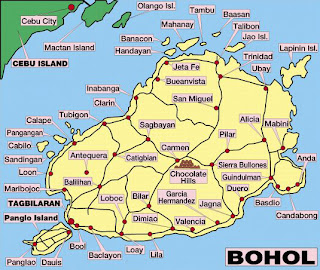Tagbilaran City, is Bohol's capital concealed from the open sea by the island of Panglao. It is the provincial capital of Bohol province, the center of a commerce and lone city of the island. It is the main gateway to the island province of Bohol, and is known as the "City of Peace and Friendship."
Tagbilaran City is considered one of the eight "Philippine Dream Cities" by the Institute for Solidarity in Asia (ISA), along with the Island Garden City of Samal, San Fernando, La Union, Cebu City, Iloilo City , , Marikina, Naga, Calbayog City and Surigao City. It is also considered as one of the Philippines twenty (20) "Most competitive cities" and “Pinoy Cities on the Rise” by the Asian Institute of Management Policy Center.
Tagbilaran City has an area of 3,270 hectares, 13 kilometers of coastline and forms an stretched strip with ridges and rolling hills. Two tops rise on both ends, Elly Hill (100 meters) in the north and Banat-I Hill (145 meters) in the south.
Location
Tagbilaran City is lying 630 kilometers southeast of Manila and is located 72 kilometers south of Cebu City. It is located in the southwestern part of the province, bounded on the north by the town of Cortes, on the northeastern by the town of Corella, Baclayon in east and south and west by Maribojoc Bay and the Tagbilaran Strait, respectively.
Tagbilaran City has its own airport placed about 5 minutes drive from business district. Tagbilaran Airport is the main airport of the province and serves three commercial air transportation, such as Asian Spirit, Cebu Pacific and Philippine Airlines. Regular flights from Manila, now almost daily, take about an hour and a half. In a few years, perhaps Panglao airport will be finished and ready to serve international flights soon.
Tagbilaran City harbors is the primary port of Bohol and can accommodate large commercial passenger and cargo vessels from Luzon, Visayas and Mindanao. The port serves about 5,000 passengers daily.
The Dao Integrated Terminal located in Dao district services buses and vans plying the routes to different parts of the province. The buses and trucks waiting in this place for passengers with a range of about 30 minutes from dawn to dusk. If passengers are plenty and fully loaded vehicles, it will leave immediately. If not yet full, but the appointed time is over, the vehicle has to leave to make way for the next vehicle in line.
Tagbilaran City is the commercial capital and center of government of the province of Bohol, apart from being the center of education and transport. Trade and commerce are very promising in the city, although business activities also thrive in port towns (eg, Tubigon, Talibon, Jagna, ubay) known to be the growth centers of the province of Bohol. Source: www.bohol.ph






























